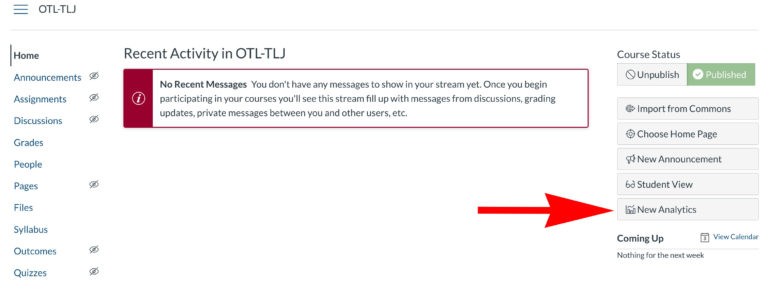In an online class we don’t receive feedback from our students in the same way that we do in a face-to-face class, so how do we know how our students are doing? Canvas has analytics that allow you to check-in on how many and which students are accessing the various items within your Canvas courses. The Canvas New Analytics tool helps you see the interaction students are having with the course materials in your class.
These analytics can help you identify which students may not be as engaged and allow you to reach out to those students. It’s vital during the first week to discover which students need extra help or guidance, so please check your Canvas analytics this week!

Student Participation and Page Views
One analytics section that can be helpful for understanding engagement or identifying barriers such as technology issues is to check the Students tab. Now that we are wrapping up the first week, in most cases, your students should have logged into Canvas and started viewing pages. If they haven’t, this may be a clue that additional support is needed. This is a section of Canvas Analytics that would be helpful to view on a weekly basis to give you an idea of who is participating with the content.
Resource statistics
What Canvas resources (pages, documents, assignments, etc.) are your students accessing? This section allows you to see the number of page views of specific resources as well as how many students have accessed them.
Messaging Students
Canvas Analytics allows you to directly message students using the Message Students Who button. You can message students who haven’t viewed a certain resource as well as students who have missing or late assessments. This is a great way to start communicating with students who may be struggling.
Beyond these analytics, keep an eye on who is turning in work, participating in discussions, and completing online assessments throughout the term. Lack of completion may point to technology issues rather than academic ones.
While these analytics have a bit of a “big brother” feel, they can be critical avenues of feedback that is harder to come by in your asynchronous portions of class. Especially given the changes to this term, we want to keep our fingers on the pulse of our students’ experiences. Hovering at the beginning can pay dividends in the long run if you are able to identify struggling students early on. For details on these reports and more, see the Canvas Analytics video for step-by-step instructions for accessing your Canvas analytics and interpreting the information:



